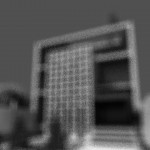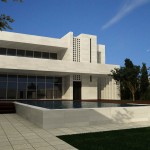Father and Daughter House and is an association and companionship of two generations in a family, in which as well as autonomy, a suitable context can be provided for interaction and coexistence. This home is located in an area of 500 square meters, nearby one of the main streets of Mashhad that was supposed to be a cheap domicile and to be demolished thereafter.
Provided plan by the employer, was a residential duplex that could be divided in two separate units in future for the daughter that is why this goal was central to the design idea. To increase the visual connections in the project, as well as spatial connections, measures should be taken in order to drive the project more dynamic, and connection achieved.
Mayan Villa is located on the outskirts of the third summer tourist village of Mashhad, which is 1800 years old. A land with an area of 265 square meters with a width of 9 meters, on a rocky land with a steep slope, which its special character is a pristine landscape and its connection with the context. Consequently, the creation of a harmonious relationship between the volume and the context with the slightest change in the historical-natural form of the context was the most important idea of the project for the designing team. In this regard, the study and complete identification of indigenous patterns, from the morphology of the texture of the historic village to the ecology of the natural environment, helped greatly to form the concept of project.
This house is defined as a four-story building located on a piece of land with an area of 250 Square Meters. Aims of this project were focused on finding another answer for the view, perspective, overlook and privacy.
Inspired by the extrovert Iranian architecture found in the old villages around Mashhad including Kang and Azghad as well as the more developed ones in the North of Iran, the whole project was built as a loggia and a window and there is a smaller terrace inside the second floor.
Lattice design of this window is made according to the Iranian models while enjoying a more modern geometry which opens a wide window to its surroundings and keeps the privacy properly. In a layer outside the private area, the terraces revive the forgotten social interaction once existed between the landlord and the neighbors.
Of today’s architecture concerns, in addition to many related issues, it’s cultural debates, which the designing team of this project has been attempted to create spaces in the house, which eliminate the problem of the internal multi-layer curtains that prevent taking advantage of the project perspectives. In this building, the terraces and parts of the living space and even six glass bathrooms in 6 floors, have been located in the main facade, which through playing with light and shades as well as the hollow and full of the vertical blades of the design, brings the view of the southern mountains of Mashhad into the house without any overlooking from the units facing the building. This visual interaction on the sidewalk wall is also in place with a green axis, which gets various definitions from the sidewalk to the end of project in the open, semi-open, and closed spaces. Using fine sliced stones in traditional bricks configuration for reduce the costs seriously, as so putting this material alongside wood has made the project more intimate. Another challenge of the project was to observe the 45° urbanization rule with the lateral neighbors, which has formed the interconnected masses in this hypothetical privacy.
Considering the special location of the project, proximity with the linear park and non-adjacency on each side and the visibility of the building from the specific urban locations, dimensional design of the project has been of great significance. Dimensional design of this project has been done with Iranian approach and by the inspiration of four-vaulted (i.e. Chahar Taqi) and developed in modern patterns and asymmetrical. The details utilized in the façade are new and all come from the traditional Islamic-Iranian architectural elements
Dimensional design of this project has been done with Iranian approach and by the inspiration of four-vaulted (i.e. Chahar Taqi). Since the main wide façade of the project is on the west wing, Iranian shades are applied to block harmful sun light. The building façade has two layers made of brick and marble; the first shade layer is made of marble. In fact, these shades besiege the façade of the building like a crust. The second layer is consisted of bricks that every four of them (that are in vertical position), share one similar color and are considered as one module.
In order to put more emphasis on the entrance of the building, the shade layers are broken in the corners. Moreover, the sky line of the building is gained from some Iranian architectural patterns.
Idea:
In fact, this project is in the overview plans of this office, because it was referred to us at the point of implementing the columns and cores of the shear walls on two floors and through maintaining the mass laying limitations and plan, the main structure of the plan was changed and revised. Certainly without maintaining these restrictions, the possibility of more maneuvers would have been provided for the designer.
This building has two underground floors with the parking, pool and storerooms application. Its pool was also added to the work during the overview. The ground floor has a lobby, auditorium, gym and children’s play area, coffee shop and play area. Five floors have two units and eight floors are single-unit and a duplex penthouse, are all units of this project.
The facade of the project consists of a plate which seems as if, as a result of lightning it has been cut with a special form. This plate with a variable opening in some parts of the main terrace of the units, which are located in the middle of volumes has created privacy and provides comfort for the residents.
The front space of the building at the edge of the street, relatively open connection to the adjacent lane and sidewalk has created an intimate bond with its surrounding environment.
1-By studying the mass and space system as well as the operating system of recreational and residential spaces in the site of the project, we concluded that the site should be defined in three levels and lay out based on the triple definitions: privacy of performance systems, access, mass and space. General definition, semi-private, full private with linear organization were planned, considering the geometry and stretch of the site.
2-According to the study of the psychological sense of the colors in recreational and residential applications we have reached this conclusion that due to the accompanied nature of the project with the nature and the convey of the refinement sense, we should move towards pure colors, so we found the response in white color.
3-the nature of weekend recreational spaces requires creating quiet spaces, therefore, the summer porch overlooking the water with a maximum depth of visibility was designed. Semi-transparent spaces (porch) with the cooling and climate influence were also considered in the process of designing. Layered plates placed in the plan perform its own play of light and special shade in the morning and at midday and grants its own flavor and atmosphere to the porch of the project. Considering the location of the site in the plain, the presence of existing green layers in the roof plates, it brings the climate moderation.
4-during the stages of designing and creating the form, it was also attempted to observe the concepts of composition in accordance with the principles. Designing the broken skyline with the withdrawal of the horizontal axis and its combination with the entrance element which is raised as the most significant part was designed as vertical element.









